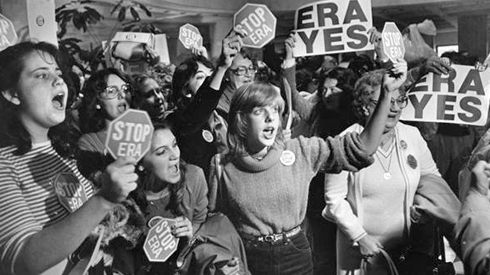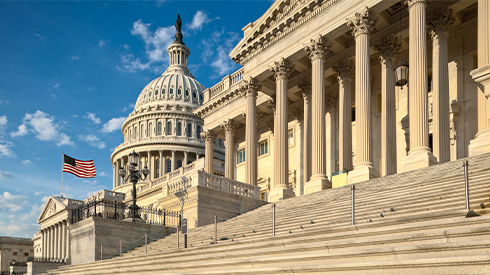The Equal Rights Amendment: Its History, Its Meaning, and Where It Stands Now


First drafted nearly 100 years ago, the Equal Rights Amendment appeared to be nearing ratification in the ’70s but was stopped in its tracks, and for good reason.
It was largely American women who campaigned against it and helped others understand the damage it would wreak upon the country.
Thanks in large part to the STOP ERA campaign, lawmakers realized the amendment would have unleashed a cascade of government actions that would harm women.
This included government-financed abortion, the legal dissolution of biological differences between men and women, and restrictions on women’s legal rights in matters of divorce.
Today, the Equal Rights Amendment is an even worse idea than it was in the ‘70s. The ERA centers on the word “sex” at a time when ideologues and activists are aggressively pushing to disassociate the term from biology and reinterpret it to include “gender identity.”
That increases the danger that “sex” becomes meaningless, opening the door for men who identify as women to compete in—and dominate—women’s sports, and for men to enter into shelters designed to protect women who have suffered domestic abuse, rape, and trafficking.
The name “Equal Rights Amendment” makes the initiative sound beneficial, but in reality, it’s an unnecessary amendment that threatens women’s fundamental rights.
What is the Equal Rights Amendment?
The saga of the Equal Rights Amendment has been a long one.
The amendment claims to end discrimination against women by erasing the distinctions between the sexes in matters of divorce, employment, property, and more.
First proposed in 1923, the Equal Rights Amendment didn’t receive Congressional approval until 1972, after which it went to the state legislatures for ratification. For the amendment to be ratified, three-fourths of the states had to ratify it within seven years.
The Equal Rights Amendment had strong bipartisan support in the ‘70s, and it seemed bound for ratification—that is until mom, wife, and political advocate Phyllis Schlafly came along and mobilized a grassroots campaign against it.
As a result, the amendment not only failed to gain the support from the states necessary for ratification, but five states that had initially approved the ERA eventually reversed their positions, rescinding their support of the amendment.

What happened to the Equal Rights Amendment?
Thanks to Phyllis Schlafly’s STOP ERA campaign, made up of concerned women from all walks of life, support for the Equal Rights Amendment dissipated.
In 1977, only 35 states had ratified the ERA out of the 38 needed for the amendment to be adopted. Congress had even tried to provide a deadline extension for the ERA’s ratification.
In 1982, the extended deadline had come and gone. Some states had already adopted their own versions of an Equal Rights Amendment to their state constitutions, and many of the forewarned harms came to pass.
That reinforced the resolve of lawmakers, who knew the ERA would be even more devastating if ratified federally. Women might be subject to the draft, and any recognition of biological differences between men and women would have been dissolved.
But even though the deadline for the ERA’s ratification expired—twice over, and by a few decades—that fact has not stopped progressives from arguing that it isn’t too late to still enshrine it in the U.S. Constitution.
In 2017, Nevada became the first state to ratify the ERA since 1977—part of the proponents’ efforts to bolsters their claim that the ERA was still on the table. In 2018, Illinois signed on as well. Theoretically, 37 states had signed on at that point—with two of those states having done so far past the deadline.
In 2020, Virginia voted to ratify the ERA, claiming that its vote constituted a legitimate 38th state signature.
But when the Department of Justice told Virginia that its vote could not count since the ERA was no longer up for debate, Nevada, Illinois, and Virginia joined in a lawsuit against the National Archivist—the official charged with administering the process of ratifying a constitutional amendment.
But, despite these states’ crafty attempts to breathe life into a long-dead amendment, even President Biden’s Department of Justice recognized this attempt to resuscitate the Equal Rights Amendment was not feasible.
In January 2022, the Office of Legal Counsel in the Biden Administration’s Department of Justice announced it was defending the Archivist and reiterated its January 2020 opinion that “because 38 states had not ratified the proposed amendment before that deadline’s expiration, the ERA is not a part of the United States Constitution and the Archivist of the United States may not certify it as such.”
In February 2022, Virginia Attorney General Jason Miyares announced that the commonwealth was reversing its legal position and withdrawing from a lawsuit seeking to ratify the Equal Rights Amendment.
Regardless of the consistent failure of the ERA to achieve ratification, activists continue to insist that the ERA is alive and can still be enshrined in the Constitution. To this end, in February 2023, the U.S. Senate Committee on the Judiciary held a hearing urging Congress to recognize ratification of the ERA.
Let’s be clear: despite this latest push for ratification, the Equal Rights Amendment is going nowhere, which brings us to the question of why it was wrong in the first place.

The dangers of the Equal Rights Amendment
The Equal Rights Amendment is dangerous—and it’s been made even more dangerous since it was first introduced. Schlafly was right to halt it in its tracks.
1. The ERA could create a radical abortion regime
Activists could use the ERA to create federal protections for the abortion industry. Since 1979, several state legislatures have passed their own state ERAs. And the abortion industry has argued that state-level ERAs could be used to mandate taxpayer funding for abortions.
For example, ERAs in some states, including New Mexico and Connecticut, have been used by courts to defend taxpayer funding for abortions that are “medically necessary.”
And while funding only “medically necessary” abortions may sound reasonable, such a requirement may actually equate to funding most abortions, given the expansive definition of “health” often applied in the abortion context.
The ERA could also be used to strike down even commonsense state regulations on abortion, such as parental notification laws for minor girls seeking abortions, and laws banning abortions based on the baby’s sex.
2. The ERA threatens equal rights for women
Women deserve to be treated with equality and fairness under the law. The ERA’s removal of the distinctions between men and women in our laws threatens equal opportunities for women, putting in jeopardy the many gains women have made in employment, education, and athletics.
By leaving “sex” open to reinterpretation, the ERA invites courts to strike down many commonsense laws that benefit women, including government programs like Women, Infants, and Children (WIC) and Social Security benefits for stay-at-home mothers based on their husbands’ income.
This is all the more problematic as radical activists—and the Biden administration—continue to aggressively push for a redefinition of the meaning of “sex” in the law.
The Alice Paul Institute’s ERA website spells it out clearly: “Remaining gender inequities result more from individual behavior and social practices than from legal discrimination.”
The activists almost come right out and say it: there is no real need for the amendment—aside from the fact that the current version of the Equal Rights Amendment would allow for a rapid creation and passage of sexual-orientation and gender-identity (SOGI) laws.
3. Ratification of the ERA undermines our rule of law
Ratifying the Equal Rights Amendment decades after its expiration would undermine our rule of law. The U.S. Constitution lays out a process for ratifying new amendments. The ERA already went through this process and failed.
And if activists want to resurrect it, they’ll have to start over from the beginning. They can’t just pick up where they left off in 1979.
Even the late Supreme Court Justice Ruth Bader Ginsburg, a hero of the left and a supporter of the ERA, acknowledged as much. In 2020, Justice Ginsburg said she would like to “see a new beginning” for the amendment, and that she would “like it to start over.”
And she made similar comments in 2019, expressing her desire that the ERA be “put back in the political hopper, starting over again, collecting the necessary number of states to ratify it.”
As ADF CEO, President & General Counsel Kristen Waggoner has said, “The ERA not only undermines women’s rights and opportunities, it falls far short of the requirements to amend the Constitution. As it stands today, the ERA is legally dead and has been for the last 40 years because its proponents failed to achieve the required support from the states.”
“Following that process by starting over respects the American people and the integrity of the Constitution. And that’s good no matter what side of the aisle we find ourselves.”
The bottom line
It's time for the activists to accept what Justice Ginsburg, Virginia Attorney General Miyares, and the Biden Administration DOJ have all observed: that Congress’s deadline to ratify the ERA has long since passed, and the Equal Rights Amendment is legally dead.

